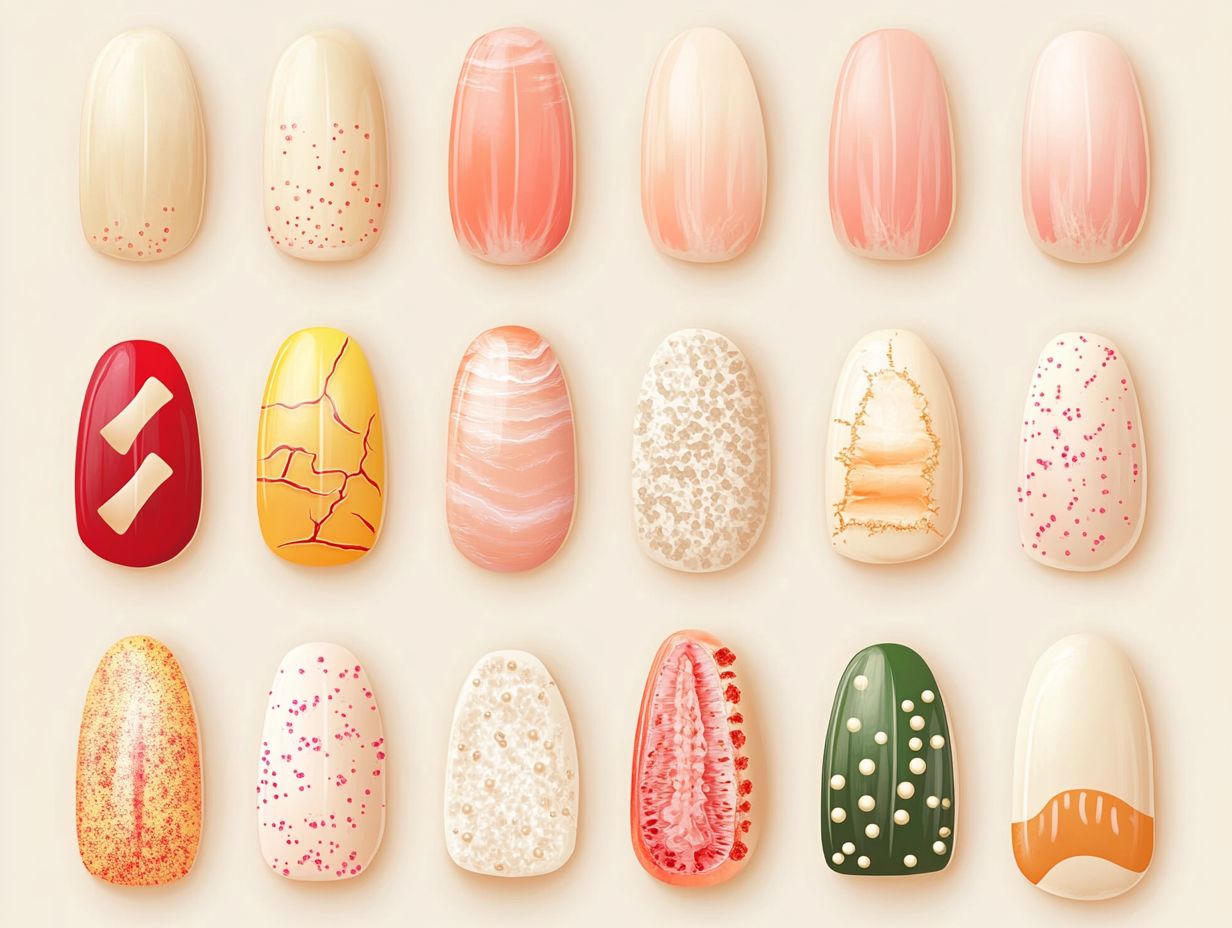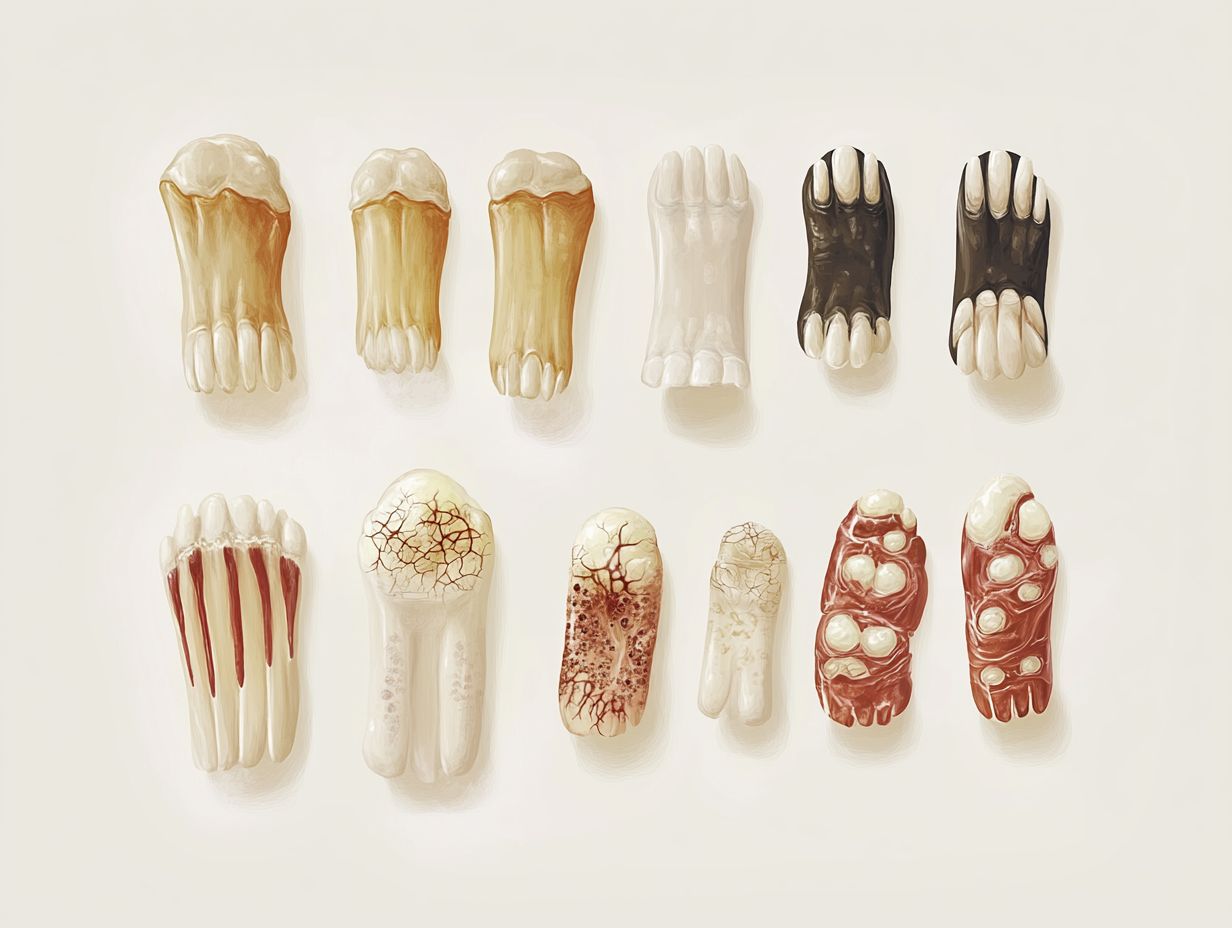Nail disorders can often signal underlying health issues or result from everyday habits.
This article explores the various types of nail disorders, from fungus to ingrown nails, and identifies their causes, including external factors like environmental exposure and internal ones such as nutritional deficiencies.
It covers effective treatment options, whether you’re looking for medical solutions or at-home remedies.
Additionally, discover how to maintain healthy nails and when it’s time to consult a doctor.
Your journey to healthier nails starts here!
Key Takeaways:

Overview of Common Nail Disorders
Nail disorders can have a significant impact on foot health and overall quality of life, presenting in various forms, including nail psoriasis, nail thickening, and other toenail issues. These conditions may vary from mild nail discoloration to more severe ailments that necessitate medical intervention.
Understanding the common types of nail disorders is crucial for effective at-home care and for addressing symptoms with the assistance of a qualified healthcare provider. Early identification and treatment are essential in preventing complications that may result from untreated nail conditions.
Types of Nail Disorders

Nail disorders encompass a diverse range of conditions, including nail psoriasis, ingrown toenails, and fungal nail infections, each presenting unique characteristics and requiring specific treatment approaches.
One notable condition, onycholysis, involves the separation of the nail from the nail bed, often resulting in discoloration and pain. This condition may arise from trauma, infections, or even underlying systemic issues, thereby affecting not only the aesthetic appearance but also overall foot health.
Paronychia is another prevalent ailment characterized by inflammation of the skin surrounding the nails, typically caused by bacterial or fungal infections. This condition presents with symptoms such as swelling, redness, and pus.
Onychogryphosis is marked by thickened, curved nails, which can cause discomfort and lead to further complications if left untreated.
A comprehensive understanding of these disorders is essential for effective management and the maintenance of optimal foot health.
Causes of Nail Disorders
Nail disorders can develop due to a combination of external and internal factors, including infections, injuries, and systemic conditions such as psoriasis and diabetes. These disorders can significantly impact overall foot health.
External and Internal Factors

Both external and internal factors significantly influence the development of nail disorders. External factors encompass environmental elements, while internal factors include conditions such as diabetes and fungal nail infections.
Regarding external factors, trauma to the nails resulting from activities such as sports or improper footwear can lead to conditions that compromise nail integrity. Additionally, exposure to harsh chemicals found in cleaning products or beauty treatments can exacerbate issues like brittleness and discoloration.
On the internal front, individuals with genetic predispositions may be more susceptible to conditions such as psoriasis, which can severely impact nail health. Chronic diseases, including circulatory problems, can further impede nutrient delivery, complicating the ability to maintain healthy nails.
Together, these factors highlight the interconnectedness of overall health and the well-being of the feet.
Treating Nail Disorders
Effectively addressing nail disorders requires a comprehensive approach that integrates medical treatment options with at-home care strategies. This may include the use of topical treatments and oral antifungal medications to restore healthy nail conditions. For more information, you can visit Common Nail Disorders and How to Treat Them.
Medical and At-Home Treatments

Medical treatments for nail disorders frequently involve prescription medications, such as Humira for nail psoriasis, while at-home treatments emphasize daily care practices aimed at maintaining nail health.
In instances of fungal infections, oral antifungal medications, including terbinafine, may be prescribed to effectively address the infection internally. Adhering to proper nail hygiene, such as regular nail trimming and the use of antifungal powders, can aid in preventing recurrence.
Biologics, which specifically target pathways in the immune response, also show promise for individuals experiencing severe nail conditions. It is imperative for individuals to establish a consistent care routine that incorporates moisturizing and the avoidance of harsh chemicals.
Recognizing symptoms such as persistent pain, discoloration, or separation from the nail bed is crucial in determining when to seek professional medical advice for further evaluation.
Preventing Nail Disorders
Preventing nail disorders is most effectively accomplished through a combination of healthy habits and proper hygiene practices. These factors are essential in maintaining optimal foot health and in preventing common toenail issues.
Healthy Habits and Hygiene Practices
Maintaining healthy habits and proper hygiene practices is vital for effective nail care, as they significantly diminish the risk of developing nail symptoms and disorders.
Incorporating regular foot cleansing into daily routines not only removes dirt and bacteria but also enhances circulation, which is essential for robust nail growth. Coupling this with appropriate nail trimming techniques prevents the occurrence of ingrown nails and reduces the likelihood of infections.
Regarding footwear, selecting breathable options constructed from materials that facilitate air circulation plays a crucial role in moisture management, subsequently lowering the risk of fungal infections.
Collectively, these practices create a comprehensive approach to foot health, effectively preventing nail diseases while promoting comfort and overall well-being.
When to See a Doctor
Understanding the appropriate circumstances for consulting a physician regarding nail disorders is essential for effective treatment. This is particularly important when signs and symptoms suggest the presence of potentially serious conditions that necessitate medical intervention.
Signs and Symptoms that Require Medical Attention
Recognizing the signs and symptoms that require medical attention is essential for preventing complications associated with nail disorders and ensuring proper treatment from a healthcare provider.
Individuals should remain vigilant regarding specific indicators, such as excessive nail thickening, persistent pain that interferes with daily activities, or visible signs of fungal infections, including discoloration and brittleness.
If changes in the shape or texture of the nails are observed, it may indicate an underlying health issue that warrants further investigation. Failing to address these symptoms could result in severe consequences, such as the spread of infection, chronic pain, or even the loss of nails.
Prompt consultation enables early diagnosis and treatment, thereby minimizing the risk of complications and promoting overall nail health.


